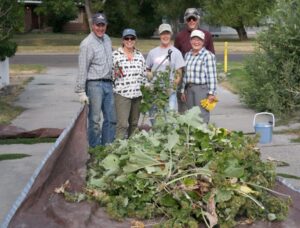
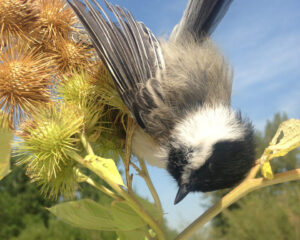
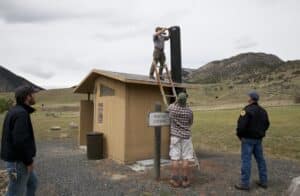
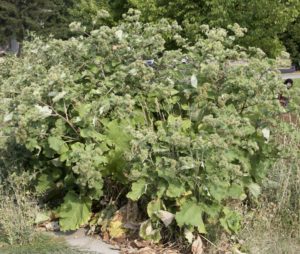
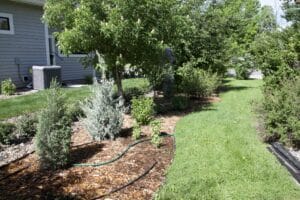

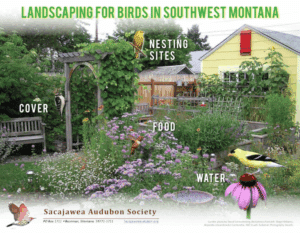
Sacajawea Audubon Projects
Bird-Friendly Landscaping
Sacajawea Audubon Society invites you to download the bird-friendly landscaping brochure Landscaping for Birds in Southwest Montana. Inside you’ll find helpful tips, a plant list of trees, shrubs and perennials, and some landscape design examples. Whether you are starting with a brand new house or an existing yard, you can turn your yard into an inviting haven for birds. Our plant list features mostly Montana natives, which once established, require less water and maintenance, and are hardy for our cold winters.
For more detailed information visit our Landscaping for Birds page.
Burdock is a particularly nasty invasive weed that is spreading along many of our local favorite trails, parks, and neighborhoods as well as across Montana ranchlands. Because the plant represents a danger to birds, other wildlife, and important bird habitats, Sacajawea Audubon conducts a yearly campaign to eradicate burdock using volunteer efforts.
The Burdock Problem: Burdock can reach over 6 foot tall, with stalks of spiky purple flowers that become Velcro-like seed heads, often known as ‘cockleburs’. As the spiky flowers mature they become an increasing danger to song birds whose feathers can get entangled in them, causing the birds to die a slow death. Bats have also been found hanging dead in burdock, caught and unable to escape. You may know burdock from brushing against it and getting the burs caught in your hair, your clothes, or your dog’s fur. The burs get so entwined in fur that they are a terrible nuisance and even a danger to horses, cattle, sheep, deer, and many other species of wildlife.
Burdock is especially found in high quality bird habitat such as riparian corridors where there are shady places with moist soils, but it can also occur in grasslands and disturbed areas. In patches where burdock has been well established for years, it can create such a solid canopy of leaves that it crowds out all other native plants destroying valuable wildlife habitat.
How to identify Burdock: Burdock is a biennial, meaning it takes two years to complete its lifecycle. The first year it produces a basil rosette of large heart shaped leaves (up to 12 inches across and 20 inches long). The second year in July or early August it sends up a stalk (2-8 feet tall) with branches of purple flowers on the tips of prickly balls of burs. The burs mature and dry as the season progresses and the plant dies, leaving the burs to be picked up and spread by wildlife, livestock, dogs, and people. Each burdock plant can produce 1,000 to 10,000 seeds within its burs.
Outdoor domestic cats are a recognized threat to global biodiversity. Cats have contributed to the extinction of 63 species of birds, mammals, and reptiles in the wild and continue to adversely impact a wide variety of other species, including those at risk of extinction such as Piping Plover.
The ecological dangers are so critical that the International Union for the Conservation of Nature (IUCN) lists domestic cats as one of the world’s worst non-native invasive species.
Predation by domestic cats is the number-one direct, human-caused threat to birds in the United States and Canada. In the United States alone, outdoor cats kill approximately 2.4 billion birds every year. Although this number may seem unbelievable, it represents the combined impact of tens of millions of outdoor cats. Each outdoor cat plays a part.
Even well-fed cats will hunt and kill. Upon reflection, most cat owners will have observed this behavior. When a cat plays with a feather toy or laser, it is practicing predatory behaviors. When these behaviors continue outdoors, the results are deadly for birds and other wildlife.
Unfortunately, the mere presence of cats outdoors is enough to cause significant impacts to birds. Because cats are recognizable predators, their presence near nesting birds has been shown to reduce the health of chicks and decrease nest success.
Here are some great suggestions if you have a pet cat to keep both them and wildlife safe.
Other Human-caused Threats
Baling Twine
Baling twine is used for baling hay and straw that is fed to or used by livestock.
Because of its strength and long-life, twine does not easily decompose and will last indefinitely. Baling twine is commonly found on ranches, farms, arenas, ranchettes, stockyards and fairgrounds. Twine is made of polypropylene, a non-biodegradable plastic. It comes in several colors and also comes in mesh form. Twine is usually orange and mesh is green. Polypropylene (twine) remains in the environment for an extremely long time.
Ospreys have the bad habit of collecting baling twine to adorn their nests. Unfortunately, baling twine is a serious threat to Osprey, as they often get tangled in this very strong polypropylene rope. Baling twine has been found in nearly every nest located in a Raptor View Research study area in Western Montana. An Osprey nest that blew down in Missoula contained more than a quarter of a mile of baling twine!
The easy solution to this problem is to pick up baling twine and dispose of it properly.
Osprey & Baling Twine pamphlet
Lead Ammunition and Fishing Tackle
Lead in its various forms has been used for thousands of years, originally in cooking utensils and glazes and more recently in many industrial and commercial applications. However, lead is a potent, potentially deadly toxin that damages many organs in the body and can affect all animals, including humans. By the mid 1990s, lead had been removed from many products in the United States, such as paint and fuel, but it is still commonly used in ammunition for hunting upland game birds, small mammals, and large game animals, as well as in fishing tackle.
Wild birds, such as mourning doves, bald eagles, California condors, and loons, can die from the ingestion of one lead shot, bullet fragment, or sinker. According to a recent study on loon mortality, nearly half of adult loons found sick or dead during the breeding season in New England were diagnosed with confirmed or suspected lead poisoning from ingestion of lead fishing weights. Recent regulations in some states have restricted the use of lead ammunition on certain upland game hunting areas, as well as lead fishing tackle in areas frequented by common loons and trumpeter swans.
There are several non-lead alternatives available for use in hunting, shooting sports, and fishing activities. Click HERE for more information.
Bird collisions happen because birds see the world differently. Millions die froM collisions with man-made objects each year.
Have you heard the “thud” as a bird hits your window? You’re not alone. Every U.S. home kills about two birds each year—including long-distance migrants like Ruby-throated Hummingbirds.
To birds, trees and sky reflected in glass appear to be habitat. They fly into windows at high speeds, and the loss of life is staggering. Up to one billion birds are killed by collisions with glass in the United States every year. (There are easy ways to help!)
Information on how to prevent bird collisions with windows.
This is a program to install screens on outhouse ventilation pipes whose large diameters are enticing to certain species of wildlife such ascavity nesting owls. Birds see ventilation pipe openings as possible nesting cavities and become trapped. We have installed three vent screens at Lewis & Clark Caverns State Park, and nine vent screens at Missouri Headwaters State Park. We will continue our efforts by working with Montana Fish, Wildlife and Parks to purchase and install screens at area fishing accesses and parks.
